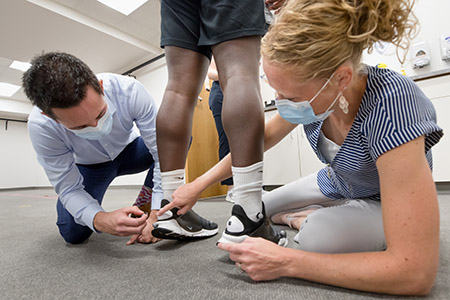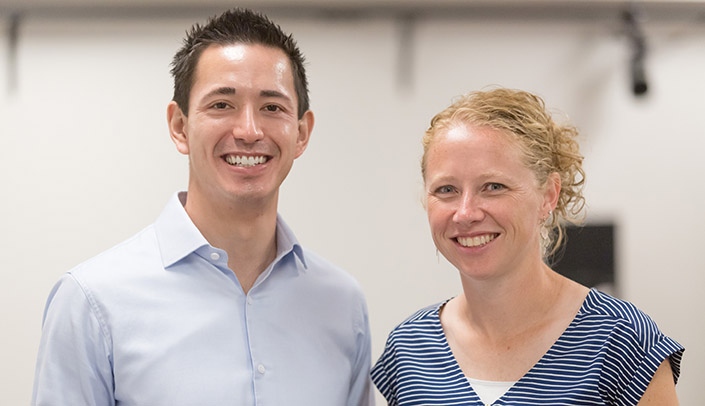Each year in the United States, 250,000 individuals will tear the anterior cruciate ligament (ACL) in their knee, and up to half will develop signs of arthritis on X-rays within 10 years. Unfortunately, evidence-based interventions to prevent post-traumatic knee osteoarthritis do not yet exist.
 |
Elizabeth Wellsandt, DPT, PhD, and Matthew Tao, MD, place reflective markers on a research subject for use in three-dimensional biomechanical analysis. |
Elizabeth Wellsandt, DPT, PhD, assistant professor of physical therapy education in the UNMC College of Allied Health Professions, and Matthew Tao, MD, assistant professor of orthopaedic surgery in the UNMC College of Medicine, have teamed up to research this issue. Dr. Wellsandt is the principal investigator of the two-year study funded by the National Institute of Arthritis and Musculoskeletal and Skin Diseases for $205,000. Other funding from the Rheumatology Research Foundation brings the total to $600,000.
“ACL tears are devasting injuries for athletes — both mentally and physically. While we have good solutions to stabilize the knee and get them back to sports, there are still concerns about the health and longevity of that joint down the road,” Dr. Tao said.
The purpose of the study is to identify markers that predict the earliest signs of poor knee joint outcomes after ACL injury. Drs. Wellsandt and Tao are measuring daily physical activity and biomechanical movement patterns in participants within one month of ACL injury and again at two, four and six-months following surgery.
“The periods before and early after ACL surgery are important to restore muscle strength and knee function to prepare for returning to sports,” Dr. Wellsandt said. “However, our team also believes that this is a critical period to keep the knee’s cartilage healthy so that arthritis does not develop at an early age. This study will identify if movement patterns and daily physical activity which can be modified during rehabilitation are indeed related to arthritis development.”
Participants will have special MRI scans both before and after surgery to provide a detailed look at their cartilage. The hope is to identify an initial target or range of healthy knee joint loading levels after ACL injury.
Their findings will provide a foundation to test the effectiveness of different regimens aimed at optimizing joint loading to reduce cartilage breakdown. The ultimate goal is to delay or prevent the onset of osteoarthritis following ACL rupture or other traumatic joint injuries.
The team also includes UNMC faculty Melissa Manzer, MD, Balasrinivasa Rao Sajja, PhD, and Stephanie Vas.

Great work, Drs. Wellsandt and Tao! This research will have a huge impact on young athletes.